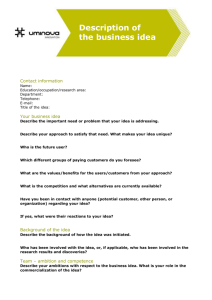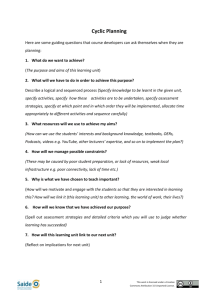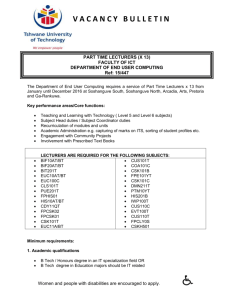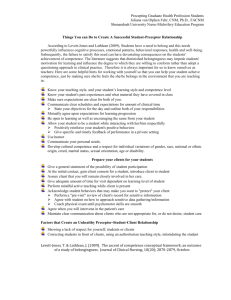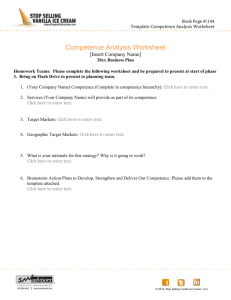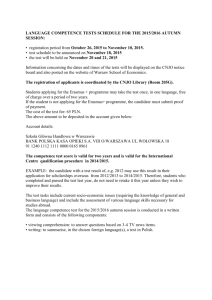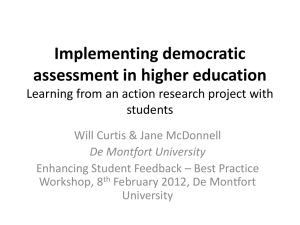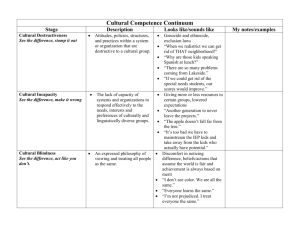Teacher contribution to educational quality in an ESP study course
advertisement
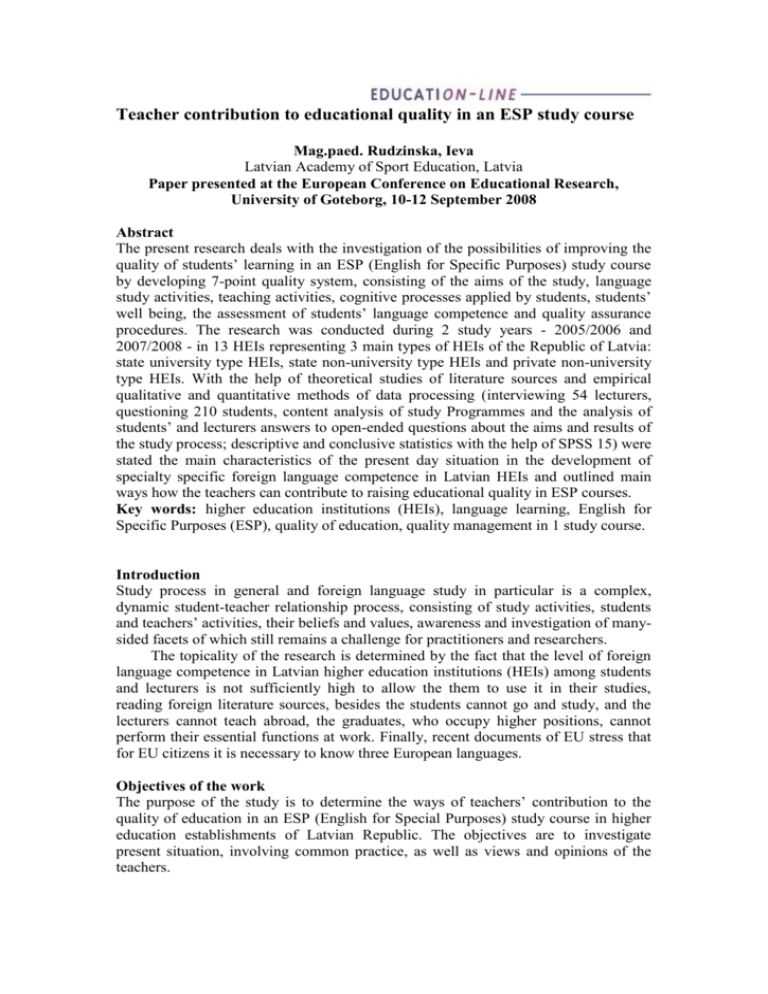
Teacher contribution to educational quality in an ESP study course Mag.paed. Rudzinska, Ieva Latvian Academy of Sport Education, Latvia Paper presented at the European Conference on Educational Research, University of Goteborg, 10-12 September 2008 Abstract The present research deals with the investigation of the possibilities of improving the quality of students’ learning in an ESP (English for Specific Purposes) study course by developing 7-point quality system, consisting of the aims of the study, language study activities, teaching activities, cognitive processes applied by students, students’ well being, the assessment of students’ language competence and quality assurance procedures. The research was conducted during 2 study years - 2005/2006 and 2007/2008 - in 13 HEIs representing 3 main types of HEIs of the Republic of Latvia: state university type HEIs, state non-university type HEIs and private non-university type HEIs. With the help of theoretical studies of literature sources and empirical qualitative and quantitative methods of data processing (interviewing 54 lecturers, questioning 210 students, content analysis of study Programmes and the analysis of students’ and lecturers answers to open-ended questions about the aims and results of the study process; descriptive and conclusive statistics with the help of SPSS 15) were stated the main characteristics of the present day situation in the development of specialty specific foreign language competence in Latvian HEIs and outlined main ways how the teachers can contribute to raising educational quality in ESP courses. Key words: higher education institutions (HEIs), language learning, English for Specific Purposes (ESP), quality of education, quality management in 1 study course. Introduction Study process in general and foreign language study in particular is a complex, dynamic student-teacher relationship process, consisting of study activities, students and teachers’ activities, their beliefs and values, awareness and investigation of manysided facets of which still remains a challenge for practitioners and researchers. The topicality of the research is determined by the fact that the level of foreign language competence in Latvian higher education institutions (HEIs) among students and lecturers is not sufficiently high to allow the them to use it in their studies, reading foreign literature sources, besides the students cannot go and study, and the lecturers cannot teach abroad, the graduates, who occupy higher positions, cannot perform their essential functions at work. Finally, recent documents of EU stress that for EU citizens it is necessary to know three European languages. Objectives of the work The purpose of the study is to determine the ways of teachers’ contribution to the quality of education in an ESP (English for Special Purposes) study course in higher education establishments of Latvian Republic. The objectives are to investigate present situation, involving common practice, as well as views and opinions of the teachers. Theoretical background Quality in higher education has many meanings (Harvey, Green, 1993), in the present investigation we are dealing with quality as transformation. Quality as transformation is connected with the increase of the students’ role in active formation of competence, students’ involvement in decision making. Formal qualification not always reflects students’ empowerment, quality should be evaluated not only according to the results, but also process. Main stress should be laid on structures and processes within institution, which encourage dialogue, team work, power delegation to students, domination of responsiveness and trust. In short it is shift from teaching to learning, formation of knowledge, skills and values, as well as the development of critical thinking. To ensure it is essential to use feedback between lecturers and students. 1. Aims According to the ideas of total quality management (George and Weimerskirch, 2002) quality management means quality of the results and quality of the process, which starts with the setting of appropriate, realistic, controllable aims. “If we remove the aim, process management is left in the realm of guess”, stress the authors (Ibid, p. 70). The aims should be set at the beginning of the course, monitored during it and their achievement evaluated at the end of the course. 2. Language learning activities Language learning process consists of different study, developing 4 language skills – reading, speaking, listening and writing. 2.1. Reading Dominowski (Dominowski, 2002) considers reading being activity requiring higher order form of cognition than the one needed in employing other language skills – metacognition. Doff (Doff, 1988) considers reading skills being universal skills, employing common judgment and interpreting skills, which help to deduce meaning from discourse. Therefore he advices to pay main attention not to the forms of the text, but to text interpreting strategies, which allow to understand text forms being at the surface of it. Reading is connected with analysis and synthesis, and the latter should dominate (Pasov, 1987). Therefore it is useful to use such tasks as asking questions about the text and subtext, guessing meaning of the unknown words, connecting the information with the one already known, etc., making plans, writing summaries of the text, making dialogues about the text. To develop discourse competence, which is part of reading competence, the texts used should be and sufficiently long and preferably authentic (Nunan, 1995). By using authentic materials, representing global culture through different contexts (Krumsch, 1993) the student can learn to deal with information, which means not only obtaining it, but also finding, connecting and evaluating facts and information (these are principally new reading skills, stresses in the abovementioned Report to UNESCO). 2.2. Speaking Speaking activities are the ones, which are most used and demanded in everyday life, most enjoyed by the students (Nunan, 1991). During the last phase of further development of speaking skills, where lexical elements are used in novel situations, attention should be paid to dialogues, individual and group presentations, discussions (Pasov, 1977). 2.3. Writing Writing due to many circumstances is the most difficult productive language skill, which demands good command of written form of language (e.g., Pasov, 1977, Byrne, 1991). On the other hand, it is the most long lasting form of language, the most complete form of expression of people’s thoughts, and it could be also sufficiently individualized, thus taking into account different levels of students’ language competence. To promote deep learning, writing should be taught both like a result and process (see e.g., Dudley-Evans and John, 1998), including such study activities as essay and report writing, and proper attention should be paid to authentic writing with real reader, e.g. in special student made magazines. 2.4. Listening Listening is based on the knowledge of phonological, lexical, syntactic and semantic structures, as well as about the discourse (Buck, 2001). Pasov (Pasov, 1977) acknowledges that listening is active thinking process, which demands creative combination and usage of the skills according to the situation. Buck (Buck, 2001) points out that with listening texts are greater problems than with reading texts, which are not widely accessible. The lecturer has to use readymade recordings, record himself or use the recordings made by students. Rost (Rost, 1994) emphasizes that authentic language heard in these in these recordings, is a challenge for students to understand the language used by native speakers. To make listening easier the lecturers often use ready-made recordings, but Rost advises to use authentic recordings and lead students’ listening process by special lexical, grammatical, etc. exercises. 3. Cognitive processes Regardless of the skill being developed, the lecturer should also be aware of mental processes, employed by learners. Mc Cafferey reminds (Mc Cafferey, 2004) that in education and higher education especially successful education has always been encouraging students to use higher order thinking skills. To the lowest cognitive processes Bloom, the creator of the taxonomy of cognitive processes (Bloom, 1984) remembering, taking notes, describing, etc., to higher – referring, connecting, applying, etc., to the highest – analyzing, hypothesizing, etc. If only lower order cognitive skills are used in the study process, low is also the involvement of the students. The students prefer surface or deep approach to the study process, but study situation to a great extent determines which approach will be used (Biggs, 2003). 4. Teaching activities Considering teaching activities in promoting students’ learning, the emphasis should be shifted from information giving to helping the students to search, organize and use knowledge, and teachers from soloists are advised to become promoters, mentors (Report to UNESCO, 2001), or even choreographers (Donaldson, 1999) or conductors (Dominowski, 2002). Three main teachers’ competences include: Subject specialist: teacher as a specialist of his study course, as a mediator between study subject, especially its basic considerations, and the student. Teaching competence: lecturer as a teacher – creator of motivation, including connecting it with the future profession, cultivator of values, enricher of students’ learning experience, the creator of studies promoting atmosphere, including sufficient challenging activities, and assessor of students’ achievements. Students’ learning leader’s competence: students’ resource and help, promoter of students’ cooperation, mediator between institutions requirements and the student, as well as between study materials and the student, capable of reflection and learning himself, responsible for quality management of students’ learning. Mediator’s role includes adjusting study materials to needs and wishes of the learners, using different tasks for different learning styles. New development in language teaching is simultaneous teaching language and another subject, and to perform this the lecturer should have all three competences, namely he should now well this another subject, be able to teach it creatively and monitor students’ progress. 5. Students’ well-being Lecturers should also be aware of students’ “psychological comfort” during study process. Knoop (Knoop, 2001) considers that balance should be achieved between students’ strain and boredom, between known and unknown, and to achieve this, the tasks or problems should be neither too easy, nor too difficult. The students with higher competence need higher challenge, but for the students with lower competence high challenge can cause anxiety, when the students do not know how to cope with the situation. If the anxiety is too high, challenge should be diminished, so that students can feel good and study with joy. People learn the best, if they are in pleasant physical and social atmosphere, where they are given sufficiently challenging tasks, where is used meaningful contents, and teachers and students have common higher aims. Pasov (Pasov, 1977) reminds that foreign language courses have specific demands towards micro climate, because in these courses should prevail communication atmosphere, and lecturers and students should become partners in communication. 6. Language competence assessment Realizing shift from teaching to learning language competence assessment should change from competition and threat to a tool promoting learning by adequate feedback, instead of testing knowledge should be tested skills and competencies, testing should be based not on norms, but on criteria. Assessment criteria should be based on assessment aims. Pasov (Pasov, 1977) considers appropriate in speaking and writing correct only these mistakes, which distort the meaning. Dudley-Evans and John (Dudley-Evans and John, 1998) advice in evaluating presentations pay attention not only to linguistic criteria, but also to extra-linguistic factors, body language, etc. Finally, Bachman (Bachman, 1990) warns: “if the only criteria in tests will be grammatical correctness, test taker will avoid use structures she is not sure about. There are also such ways of measuring competence, which do not have “right answers”. It concerns attitude and understanding, and reflect test takers feelings and way of thinking.” Bad assessment procedures promote surface learning and ineffective remembering, but open tests, as well as essay writing and problem solving promote deep study process, based on understanding and applying. Many-sided assessment of students’ achievements can be derived from students’ Portfolios, students made magazines a.o. forms of students’ deep involvement. The students must be given feedback about the results of assessment works, which informs them about their progress, promotes successful activity, and in order to sustain their well-being is neither hindering, nor humiliating (Knoop, 2001). 7. Quality assurance procedures To secure satisfactory outcomes, should be provided necessary resources (George and Weimerskirch, 2002). Basic resource of education institutions are people, but lecture rooms, scope and availability of library sources, computer labs, etc. facilities should also be provided. It is also necessary to raise awareness about outer resources (graduates, employees, colleagues from other HEIs) and use them in quality management (O’Connell Rust and Helen Freidus, 2001). Basic outcomes of foreign language study course could be students’ communicative competence in specific field, as well as students’ ability to enter job market and show sufficient level of language skills needed. Research design and methodology According to literature analysis quality management process and product in an ESP course can be evaluated according to 7 main blocks (Rudzinska 2007:1,2): 1. Aims 2. Language learning activities 3. Cognitive processes 4. Teaching activities 5. Students’ well-being 6. Language competence assessment 7. Quality assurance procedures. With the help of students’ and teachers questionnaires we pursued to find out what is the situation in each of these 7 blocks: what students and teachers do in language study process, and what is their opinion about the necessity of practicing different activities for promoting quality of language learning process and product. Description of research implementation The research was conducted during 2 study years - 2005/2006 and 2007/2008 - in main types of HEIs of the Republic of Latvia (altogether 13 HEIs). Main types of higher education institutions in Latvia are state university type HEIs, state nonuniversity type HEIs and private non-university type HEIs. Research consisted of interviewing 54 teachers and questioning of 210 students about different aspects of quality management of students’ learning (according to 7 above described blocks). Data collection and analysis The data were analyzed with the help of SPSS 15 program, determining the characteristics of descriptive statistics, including means and standard deviations of the frequency of practicing of certain activities of quality assurance and of the opinion of students and lecturers. Further were estimated correlations between different activities of one quality assurance block, and, where possible, were determined main factors of the blocks and their weights. 1. Aims This block in the questionnaire consisted of 7 questions, where in dichotomous scale the respondents had to answer if they are aware about the aims of the study course, if they had set individual aims at the beginning of the study course, if they monitor their achievement during the course, if they know students’ language proficiency level according to Common European Framework or CEF and Secondary school finishing exams, and finally there was an open-ended question asking to state the aims of the study course. To analyze the answers to the open ended question was designed code system, consisting of 2 main groups: the aims connected with teaching and with learning. The results are the following. 2. Language learning activities The respondents were asked to answer in dichotomous scale the questions about practicing different forms (20) of developing 4 language skills. Then the frequency of practicing different language skills was obtained. 3. Cognitive processes The teachers and the students were asked to answer in dichotomous scale the questions about employing by students different mental activities (25). Then the frequency of practicing different language skills in the opinion of the students and the lecturers was obtained, and the mean values compared. 4. Teaching activities The respondents teachers where asked to answer if they practice the mentioned activities (dichotomous scale), and the respondents students were asked to rate these activities according to their importance (Likert 4 point scale). 4.1. Teachers’ view about the frequency of practicing different teaching activities. The teachers were also asked to answer in dichotomous scale the questions about employing by them different teaching activities (19). Before analysis inner consistency of the data was tested, normal distribution of the data checked by performing one-sample Kolmogorov-Smirnov test, and then Independent samples T test carried out to compare the frequency of practicing different teaching activities. 4.2. Students’ opinion about the importance of practicing different teaching activities with the aim of raising students’ language competence. Students had to rate the importance of practicing by lecturers the same different teaching activities (19). In response the respondents had to use 4-point Likert scale. First reliability statistics was estimated by estimating Cronbach's Alpha, then normal distribution was tested with One-Sample Kolmogorov-Smirnov test and statistically significant differences were calculated with the help of T-test for independent samples. Finally factor analysis of 19 items was carried out, starting with KaiserMeyer-Oklin test and Bartlett’s Test of Sphericity. 4.3. Teachers opinion about the importance of practicing by them different activities of quality management in order to raise students’ language proficiency. The teachers had to rate with the help of 4-point Likert scale the importance of practicing by them different quality management activities in order to raise students language competence connected with their specialty. Afterwards factor analysis was applied to reveal most important quality management procedures practiced by teachers, prior which the tests confirming the appropriacy of using factor analysis were performed. 5. Students’ well-being The students were asked to respond in 4 point Likert scale (1- fully agree, 2 – agree, 3 – disagree, 4 – fully disagree) to the statement that they feel good working in different forms of study organization and express their attitude to the statement that they study according to their abilities, and to 2 control statements asserting that the tests and exercises are either too difficult or too easy for the students. 6. Language competence assessment The students were asked to respond in dichotomous scale to the questions inquiring about practicing different forms (5) of student assessment. 7. Quality assurance procedures In this block the respondents had to rate with the help of 4-point Likert scale the existence of different (13) quality management activities practiced on institutional level and leading to the improvement of students’ learning. The results were processed with the help of factor analysis. Results and conclusions 1. Aims With the help of descriptive analysis of the data we obtained the following results: Although about 2/3 of the students assert that the aims of the study course are clear to them, considerably less students can describe them. Students are not aware of their language skills according to CEF levels Most teachers consider the most important aim of the study course being the use of knowledge and skills, but most students think it is connected with acquiring knowledge. Teachers mention such aim of the study course as raising awareness of one’s and other cultures, but students have not mentioned it. Students mention such inadequate aims as acquiring the course, getting satisfactory mark, as if the aim of the course lay in the course itself. Conclusions: aim setting is one of the weakest points of the quality system of an ESP course, the lecturers’ can do much more in raising students’ aim awareness by setting, monitoring and checking them together. If the lecturers not only in words, but in everyday practice pay greater attention to language skills development than to acquiring “pure” knowledge, as well as to the development of individual’s culture awareness and intercultural competence, then the students will also widen their understanding about the aims in language learning. If students’ only aim is getting satisfactory mark, the lecturers could explain that to get it the students should be able to demonstrate not only knowledge, but also skills and competencies. Greater emphasis could be laid also on developing self-assessment skills, encouraging the students to assess their language proficiency according to CEF levels. 2. Language learning activities Main differences (Sig<0.05) between the frequency of practicing language skills are the following: Speaking skills are practiced most of all, especially discussions (mean = 0.96), then dialogues (mean = 0.84), the least – group presentations (mean = 0.67). Least of all are practiced listening skills, to develop them students more frequently listen to cassettes attached to textbooks (mean = 0,59) and less frequently listen to authentic recordings, watch authentic videos and films (mean = 0. 24). From reading skills more than other are practiced reading texts from textbooks (mean = 0.89) The least are practiced reading longer pieces of literature (mean = 0.49) and translating summaries into foreign language Error! Not a valid link.0.54). From writing activities most frequently are practiced summary writing (mean = 0.67), then – essay writing (mean = 0.56), the less are practiced such to deeper learning oriented forms of writing as the formation of students learning journals (mean = 0.29) and writing into students’ made journals (mean = 0.11). Conclusions: more frequently are practiced traditional forms of developing language skills, not employing sufficiently activities oriented to deeper learning. The teachers can raise the quality of the course by encouraging the students to read longer pieces of literature, listen to authentic recordings, practice authentic writing by writing in e.g. student made magazines, engage in group presentations. Also other subject lecturers can include in their reading lists more sources from foreign literature. 3. Cognitive processes 3.1. Teachers’ opinion about frequency of cognitive processes employed by students With the help of descriptive statistics were determined the means of cognitive activities employed by students, the most striking differences in the frequency are assembled in Table 1. Table 1. Teachers’ opinion about frequency of cognitive processes employed by students Memorize facts N Valid 52 Missing 2 Mean 1,00 Std. dev. ,000 Learn by heart Describe Explain 47 52 51 7 2 3 ,43 ,87 ,88 ,500 ,345 ,325 Apply studied Learn material from to novel each situations Hypothesize other 49 49 47 5 5 7 ,84 ,80 ,83 ,373 ,407 ,380 Table 1 testifies that the teachers think that the students less hypothesize, learn from each other, apply studied material to novel situations, describe, explain than memorize facts, memorize structures, follow the ideas of the lecturer, take notes, learn to use reference materials, etc. We can conclude that in the teachers’ opinion students still higher order mental skills employ less than lower order mental skills, because the frequency of using higher order mental skills is less than 90 p.c., but that of using lower order skills is between 90 and 100 p.c. The difference between memorizing facts and comparing, following the ideas of the lecturer, taking notes, understanding information, understanding essence of the subject, practicing applying skills, learning to use reference materials, learning to cooperate and hypothesizing is statistically significant (Sig<0.05). 3.1. Students’ opinion about frequency of cognitive processes employed by students The analysis of students’ questionnaires testifies that almost all students (about 90 p.c.) practice the following mental activities: remember facts, receive information, take notes, understand information, listen to others, learn to cooperate, read the materials and notes, acquire skills, study individually, evaluate if something is worth learning, relate new information to already acquired. More rarely (about 80 p.c.) – follow the ideas of the lecturer, compare, analyze, express their views, opinion, and learn from others students. About 70 p.c. memorize structures, apply studied material to novel situations, use new information in practice, apply skills and learn to use reference literature, from 50 to 60 p.c. describe, learn the information by heart, explain, and hypothesize. Thus the students less memorize structures, apply studied material to novel situations, use new information in practice, apply skills, learn to use reference literature, considerably less describe, explain, and hypothesize that the teachers think they do. To draw statistically significant conclusions, we first performed KolmogorovSmirnov test to find out if the data are distributed normally and then used T-test for independent samples. The results testify that the data are normally distributed, because Sig<0.05, and statistically significant differences exist between the use of the following mental activities: Students more receive information and read the materials and notes than analyze it Students more remeber facts than memorise structures, describe, explain, apply study material to novel situations Students more develop skills than apply studied material to novel siatuations and aplly skills in situations which will be at work. Conclusions: both in opinion of the teachers and students the students more use lower than higher order thinking skills, the teachers can improve the quality of students’ learning by organizing studies in such a way that higher order thinking skills are required. 4. Teaching activities 4.1. Lecturers’ view about the frequency of practicing by them different teaching activities. Cronbach's Alpha is 0.898, One-sample Kolmogorov-Smirnov test testifies that the data are normally distributed. Independent samples T test for different teaching activities reveals that the teachers practice statistically significantly less (Sig<0.05): teaching language and another subject simultaneously using different tasks for different levels of language proficiency, different exercises for different learning styles. Conclusions: lecturers can improve the quality of their teaching by adequate reaction to diversity (using different tasks for different levels of language proficiency, different exercises for different learning styles), and trying to use recently developed CLIL method, which means teaching language and another subject simultaneously. 4.2. Students’ opinion about the importance of practicing different teaching activities with the aim of raising students’ language competence. Reliability statistics: Cronbach's Alpha is 0.835. Normal distribution (One-Sample Kolmogorov-Smirnov) test: all the data are normally distributed (Sig<0.05). The results (statistically significant differences calculated with the help of T-test for independent samples) testify that: in students opinion it is not important to teach simultaneously language and another subject, and to challenge students it is statistically significantly less (Sig<0,05) important to share experience, assess students’ knowledge, show how to use information, encourage students to participate in different activities, create good studies promoting atmosphere, use different exercises for different language proficiency levels than to give new information and explain it. Conclusions: the most important teaching activities in the opinion of the students still are to give new information and explain. 19 Teaching activities were also subjected to principal components analysis using SPSS 15 version. Prior to factor analysis the suitability of data for factor analysis was assessed. Inspection of the correlation matrix revealed the presence of many coefficients of 0.3 and above, the Kaiser-Meyer-Oklin value was 0.783, exceeding the recommended value of 0.6 and Bartlett’s Test of Sphericity reached statistical significance, supporting the factorability of the correlation matrix. Principal components analysis revealed the presence of 5 components with eigenvalue exceeding 1, explaining 26.72%, 8.38%, 7.43%, 6.70% and 6.08% of the variance respectively. The Varimax with Kaiser Normalization rotated solution revealed the presence of 5 components showing a number of strong loadings. Component 1 – students’ involvement – includes students encouraging to participate in different activities, creation of good studies promoting atmosphere, promotion of cooperation, sharing experience, students’ consulting, promotion of students’ studying. Component 2 – revealing basics, essentials of the study subject – includes paying special attention to revealing these basics, students’ assessment, students’ motivating, getting students interested, students challenging. Component 3 – adjusting to diversity – includes using different exercises for different language proficiency levels and learning styles (0.795), creation of good studies promoting atmosphere and simultaneous teaching of language and another subject. Component 4 – adequate explanations – includes explanation and interpretation of information, giving of information, students’ consulting. Component 5 – connection with future profession – includes showing how to use information and connecting it with future profession. Results: most important components of teaching activities in the opinion of students are students’ involvement, revealing basics, essentials of the study subject, adjusting to diversity, adequate explanations and connection with future profession. 4.3. Lecturers’ view about the importance of practicing by them different Quality Management Procedures aimed at promoting students’ learning. The 23 items of Quality Management Activities practiced by teachers were analyzed with the help of factor analysis. The analysis of the suitability of data for factor analysis shows that the Kaiser-Meyer-Oklin value is 0.636, exceeding the recommended value of 0.6 and Bartlett’s Test of Sphericity reached statistical significance. Principal components analysis revealed the presence of 5 components with eigenvalues exceeding 1, explaining 32.84%, 15.40%, 9.40%, 6.40% and 5.72% of the variance respectively. The Varimax with Kaiser Normalization rotated solution revealed the presence of 5 components showing a number of strong loadings and all variables basically loading on 1 component. Component 1 - cooperation with other teachers – includes sharing responsibility with other teachers of the course, all the teachers of the course being members of a team, consulting with other teachers, documenting the results of students’ work, participation in conferences, defining indicators of students’ success, giving students enough opportunities to participate in teaching/learning process. Component 2 - be good specialist – includes being a good specialist in language, being a good manager of students’ learning, being a good specialist in language teaching, enriching students’ learning experience. Component 3 - having open mind, intrapersonal characteristics – include teaching flexibility, openness to changes, reflection on success, failures, problems, ability to be pro-active, learning from students, encouraging students feel free to express their opinion. Component 4 – interpersonal characteristics, outer dimension – includes participation in projects connected with professional sphere, passing such exams as TOEFL, having exchange students, having studied foreign language where it is spoken. Component 5 - leaving room for self-dignity - as teaching is still rather individual activity, this component is connected with just allowing teachers do their jobs and adjusting it to that of other lecturers. Results: most important factors in managing students learning in the opinion of lecturers are cooperation with other teachers, being good specialist, having open mind or intrapersonal characteristics, interpersonal characteristics or outer dimension and finally - leaving room for self-dignity. 5. Students’ well-being The results reveal that in general the students feel good working in all study arrangements, still they feel the worst working individually (mean = 2.09), the students more disagree than agree that they study according to their abilities (mean = 2.12), the greatest growth possibilities in this aspect have university students, from who only 23% assert that they study according to their abilities. Students’ choice leads to the conclusions that only about half of the students study according to their abilities, and for the same amount of students tests and exercises are too difficult, for 40% they are too easy. Conclusions: in the sphere of matching the level of challenging students’ with their language competence, language needs and interests there is still much room for improvement. The fact that students feel worse working individually can be explained, taking into account the fact that in the survey participated only Year 1 students, who apparently have not yet used to working individually, teachers can help them to become independent learners gradually. 6. Language competence assessment The results reveal that the following forms of assessment in the study processes are practiced more than others (Sig<0.05): tests are practiced statistically more than presentations, self-assessment, essays, peer assessment and portfolio assessment presentations are practiced more than portfolio assessment self-assessment is practiced more than portfolio assessment. Conclusions: to raise the quality of language competence assessment the lecturers could besides tests more use such kinds of assessment as presentations, essays, peer assessment and self-assessment, and especially students’ portfolio assessment. The mentioned forms of assessment, coupled with the individual aim setting at the end of the study course can help the students to become more active and responsible participants of the study process. 7. Quality assurance procedures The 13 items of Quality Management Activities were analyzed with the help of factor analysis. Kaiser-Meyer-Oklin value was 0,767 and Bartlett’s Test of Sphericity reached statistical significance. Principal components analysis revealed the presence of 3 components with eigenvalues exceeding 1, explaining 28.93%, 14.37%, 10.63% of the variance respectively. The Varimax with Kaiser Normalization rotated solution revealed the presence of 5 components showing a number of strong loadings (see Table 2). Table 2. Rotated Component Matrix(a) Component 1 2 ae12 ,856 ae11 ,805 ae13 ,760 3 4 5 ,402 ae2 ,799 ae1 ,701 ae4 ,633 ae7 ,749 ae8 ,699 ae10 ,692 ae9 ,592 ae6 ae3 ,482 ,909 ,821 ae: different quality management procedures The components were explained in the following way: Component 1 - teachers’ role in quality assurance – teacher is a good pedagogue, students’ learning manager and subject specialist. Component 2 – essential factors of study process – in the study course there are enough situations where the students can use their knowledge and skills, the study course corresponds to real life needs, the teacher regularly informs me about the +/- of my studies. Component 3 - study resources and environment – the condition of study rooms is adequate, the scope of literature in library is sufficient, environment promotes learning, study rooms and library are sufficiently accessible to students. Component 4 (explaining 8.24% of total variance) – setting high requirements – the teacher sets high requirements. Component 5 - (explaining 6.89% of total variance) the results of the study process – students’ can perform communicative tasks they have set for themselves. Results: most important quality management factors on the institutional level in the opinion of the students are teachers’ role, as well as such study process characteristics as providing enough situations where the students can use their knowledge and skills, connecting the study course with real life needs, giving regular feedback to students and setting high requirements, study provision: provision of study resources and environment, and finally study results: students’ can perform communicative tasks they have set for themselves. Main conclusions From the investigation we can get certain insights into the opinions and beliefs of lecturers and students about English for Specific purposes learning process: the most important teaching activities taken alone still are to give new information and explain. most important groups of teaching activities in the opinion of the students are students’ involvement, revealing basics or essentials of the study subject, adjusting to diversity, adequate explanations and connecting studies with future profession. most important factors in managing students learning in the opinion of lecturers are cooperation with other teachers, being good specialist, having open mind or intrapersonal characteristics, interpersonal characteristics or outer dimension and finally - leaving room for self-dignity. the main component in quality assurance in the opinion of the students is teachers’ factor, then follow some essential qualities of study process, study provision, study results. The teachers can help the learners in the following ways: in everyday practice pay greater attention to language skills development than to acquiring “pure” knowledge, as well as to the development of individual’s culture awareness and intercultural competence greater emphasis could be laid also on developing self-assessment skills, encouraging the students to assess their language proficiency according to CEF levels encouraging the students to read longer pieces of literature, listen to authentic recordings, practice authentic writing by writing in e.g. student made magazines, engage in group presentations. Also other subject lecturers can include in their reading lists more sources from foreign literature. organizing studies in such a way that such higher order thinking skills as applying skills, applying studied material to novel situations, using new information in practice, learning to use reference literature, and especially describing, explaining, and hypothesizing. adequately reacting to diversity (using different tasks for different levels of language proficiency, different exercises for different learning styles), and recently developed CLIL method 1st year students need more help to become independent learners to help students feel better the lecturers could try harder to match the level of challenging students’ with their language competence, language needs and interests assessing students’ language competence the lecturers besides tests could use more presentations, essays, peer assessment and self-assessment, and especially students’ portfolio assessment. Impact of the research to European context, to other geographic areas and international community The developed quality system in ESP study course consisting of 7 blocks can be used in assuring the quality: in language courses of practically all European languages other subject study courses can employ the system by substituting language competence development activities with ones needed in other spheres. References Biggs, J. (2003). Teaching for quality learning at university, Maidenhead: Open University Press, 309 p. Bloom B.S. (1984). Taxonomy of Educational Objectives, Cognitive Domain, Longman. Buck G. (2001). Assessing Listening, Cambridge University Press, 274.p. Dominowski R. (2002). Teaching Undergraduates, LEA Publishing: London, 182 p. Donaldson G. (1999). Cultivating leadership in schools, In: Managing Schools Towards High Performance. Ed. by A.J.Visscher. Lisse: Swets & Zeitlinger Publ., 354 p. Dudley-Evans, T. and John, M.J. (1998) Developments in ESP: a multi-disciplinary approach, Cambridge: Cambridge University Press, 301 p. Guiding school change: the rols and work of change agents / Frances O’Connell Rust, Helen Freidus, ed. (2001). New York; London: Teachers College Press, 177 p. Harvey, L. and Green, D. (1993). Defining quality, Assessment and Evaluation in Higher Education, 18(1), pp. 9-34. Knoop, H. H. & Gardner, H. (2001). Good Work in a Complex World, Cambridge, Mass.: Harvard University. Kramsch, C. (1993) . Context and Culture in Language Teaching, Oxford University Press, 134 p. McCaffery, Peter (2004). The higher education manager’s handbook: effective leadership and management in universities and colleges, London, New York: RoutledgeFalmer, 322 p. Nunan D. (1991). The Learner-centered Curriculum: a study in second language teaching, London: Cambridge University Press, 96 p. Nunan, D. (1995). Language teaching methodology: a textbook for teachers, New York: Phoenix, 244 p. Pallant J. SPSS Survival Manual, 3rd edition (2007). Open University Press, 335 p. Pasov [Пассов Е.И.] (1977). Основы методики обучения иностранным языкам [Basics of the methodology of teaching foreign languages], Москва: Русский язык, 214 p. Rost, M. (1994) . Introducing listening, London: Penguin English, 172. p. Rudzinska I. (2007.1). Investigating Students’ Learning in a Sport English Study Course: A Case Study, ATEE Spring University, Vol.2, Klaipeda University, Lithuania, pp. 196-205. Rudzinska I. (2007.2). Quality System in one ESP (English for Special Purposes) Study Course – Sport English, The New Educational Review, Vol.11, No.1, pp. 261268. . The Report to UNESCO by International Commission on Education for the Twentyfirst Century, translation into Latvian (2001)., 255 pp. TQM Total Quality Management [Всеобщее управление качеством : стратегии и технологии, применяемые сегодня в самых успешных компаниях. ТQM], Stephen George, Arnold Weimerskirch, (2002)., St Petersburg [Санкт-Петербург: Виктория плюс], 253 p. Writing to Make a Difference: classroom projects for community change/ Chris Benson, Scott Chistian with Dixie Goswami and Walter H. Gooch, ed, (2002)., New York; London: Teacher College Press, 240 p. This document was added to the Education-line database on 6 October 2008

